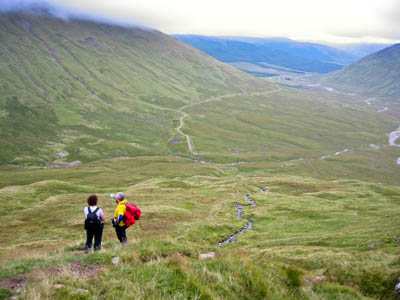
Walkers on Scotland's hills need navigation skills, says the MCofS
The head of Scotland’s mountaineering body has taken to the airwaves to defend the nation’s objection to waymarking the hills north of the border.
The debate was started by journalist Iain MacWhirter who wrote a piece in The Herald accusing Scotland’s mountaineers of elitism and nihilism by resisting the signing of routes in the Highlands and other Scottish upland areas. Most of Europe, he said, happily accepts the need to guide walkers with waymarkers.
David Gibson, chief officer of the Mountaineering Council of Scotland went head to head with MacWhirter on BBC Radio Scotland’s Morning Extra, in a sometimes heated exchange on the subject of whether hillwalkers should be provided with signs.
Mr Gibson said the idea would be ‘dumbing down the mountains’. The journalist retorted that that was an absolutely ridiculous idea.
The Herald commentator said: “We’ve got to try to manage our outdoor areas more sensibly. Hillwalking is a mass-participation sport. You’re not going to stop people going to the hills. We attract people from all over the world who come to Scotland to experience our mountains every year and they are bemused to discover that when they get there, there’s virtually no information anywhere about the main routes.
“Whereas in Bavaria, in the Black Forest in Germany, in the French Alps, indeed across France, you’ll find that almost every main route is marked, indicated so people can basically know where they are, how long they’re going to be on it and what kind of difficulty they’re going to be taking on.
“This gives people the kind of essential information so they can decide whether they want to make very ambitious excursions in the hills or whether they just want to experience them in a recreational way.”
But the MCofS chief officer countered that mountain safety was at the core of the argument against waymarking. Mountain rescue statistics suggested that poor navigation was one of the main reasons for incidents on the hills. Waymarking Scotland’s mountains might lead walkers on to high routes when they did not have the skills to find their way back down, particularly in bad weather.
“The worst example probably of incidents relating to poor navigation is the Ben,” said Mr Gibson. “Ben Nevis has a tourist track, a well worn track to the summit; there are signposts, there’s a weather forecast at the base of the mountain and cairns at the top to help people get up there.
“We still get incidents with people losing their way coming down. They lose their way when they’re tired, when they’re in the clag, when they’re in the cloud and when they don’t have the appropriate navigation skills.”
The link between Scotland’s traditions and those in Europe didn’t hold, he said. “It’s completely erroneous to make a comparison between Scotland’s mountains and the ones in Europe.
“There’s a tradition in mountaineering in Europe which is different from that in Scotland. In Europe, you’ve got a network of huts with waymarked paths. Those huts are manned and that situation simply doesn’t exist in Scotland.”
But Iain MacWhirter said: “In the French Alps, they have waymarked routes everywhere and they regard that as an essential tool of mountain management and essential for protecting the safety of people who go on the mountains.”
The MCofS says it aims to encourage and support folk who wish to enjoy the mountains, whether hillwalkers or climbers. It provides free mountain safety and navigation resources on its website and with the support of the Scottish Government also funds the Mountain Weather Information Service.
The council denies charges of elitism. “Scotland’s mountains offer a fabulous range of different experiences for people of all ages and abilities. Being self-reliant – having necessary basic skills – is the only way to enjoy these experiences as safely as possible,” it says.
The MCofS believes waymarking would encourage people to venture beyond their capabilities and get into difficulties. Scotland’s weather, poor visibility, wind, rain, frost, and snowfall at pretty much any time of the year can all remove, damage or cover waymarks.
Another major issue is who would decide where the waymarks were placed; how far apart; which design and type of waymark and how they would be maintained. Crucially, the council asks, who would be liable if people got lost, injured or worse.
And, with Scotland’s access legislation, many walkers want to follow their own routes across the country’s mountains, rather than a set path. VisitScotland, the official tourist agency, markets Scotland’s mountains to visitors as being unusual in not having waymarked paths, offering an experience where people can enjoy the freedom of the outdoors and explore.
Mr Gibson said: “Waymarking isn’t the answer – it’s being self-reliant that will open up a world of opportunities to the hillwalker, not being made unrealistically to feel ’safe’ in an often unpredictable mountain environment.”
OMR
28 August 2009The man is a fool and better ignored.